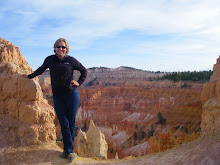A first draft of an essay for my research group's newsletter
Lake Mead National Recreation Area is on of the country’s largest national parks, the largest in the lower 48 states. The 1.5 million acres of park upland encompass the intersection of 3 of north America’s major deserts, the Mojave, the Sonoran, and the Great Basin. The park is home to many rare plant populations. The only population of smoketrees, Psorothamnus spinosus, in Nevada, the northern most community of Palo Verde, Cercidium microphyllum, the endemic and endangered bear poppy, Arctomecon californica to name a few, are surviving and thriving within the National Parks Service protection.
The desert plants’ distribution and abundance are controlled by many factors, but the primary ones in the park seem to be climate and geology. The main climate gradients are intuitive- warmer to the south and cooler to the north; temperatures also decrease with increasing elevation. The aspect of a mountain also affects the local climate; slopes that face south receive more sunlight than those that face north, often favoring different species on opposite slopes.
The controlling affect of local geology is more complicated. As anyone who has taken a scenic drive through the park knows, the rocks around change quite a bit. Volcanic ranges, sedimentary ranges, flat sandy basins, gypsum-rich rolling hills, cobbled desert pavement, black mesas, and red sandstone cliffs. Rooted in place, a plant’s main relationship with its environment is through the soils. Soil properties like mineral and nutrient composition, texture, depth, and ability to retain water have a direct affect on which plants will be able to succeed rooted in that place.
The NRCS has described and mapped more than 50 soil types within the park. Surveying which soil associations support which plant communities is key to understanding the vegetation composition across this diverse landscape.
Within the next 50 years, we expect to see some major changes to our regional climate as a result of the anthropogenic carbon dioxide levels rising in the atmosphere. One to three degree Celsius temperatures increases and more severe, less predicatable precipitation events, leading to an increase in both floods and droughts. To continue in their ideal habitat, scientists expect to see plant and animal communities migrate along climate gradients- seeking cooler conditions northward or up-slopes.
Unfortunately, community migration with changing climate is much more complicated than it sounds. Some plant species with strong dispersal mechanisms will be able to adapt quickly, others will be unable to adjust their range on a meaningful timescale. Species that traditionally cohabitate will find themselves separated; changing community dynamics. Perhaps the biggest challenge at Lake Mead, and in much of the southwest, for ecosystems dealing with the changing climate, is that the soils, rocky-outcrops, and sandy washes will all remain stationary. Species will find that their ideal climate has shifted but their ideal soils have not, creating mismatches that could potentially threaten their survival.
One of the missions of our National Parks is to protect and conserve our natural ecosystems. To figure out the most efficient and effective ways to protect the plant communities of Lake Mead NRA in the changing climate, understanding how soils-climate-species interact the first step for the park. We are currently, on a park-wide scale, to study the plants associated with the different soil types, elevations, slopes, and locations. Collecting this base-line data will help us to see how the communities change and move with a changing climate. With this new information, we can understand where to focus our conservation efforts; to protect this park and it’s ecosystems for the future.
4 years ago


No comments:
Post a Comment